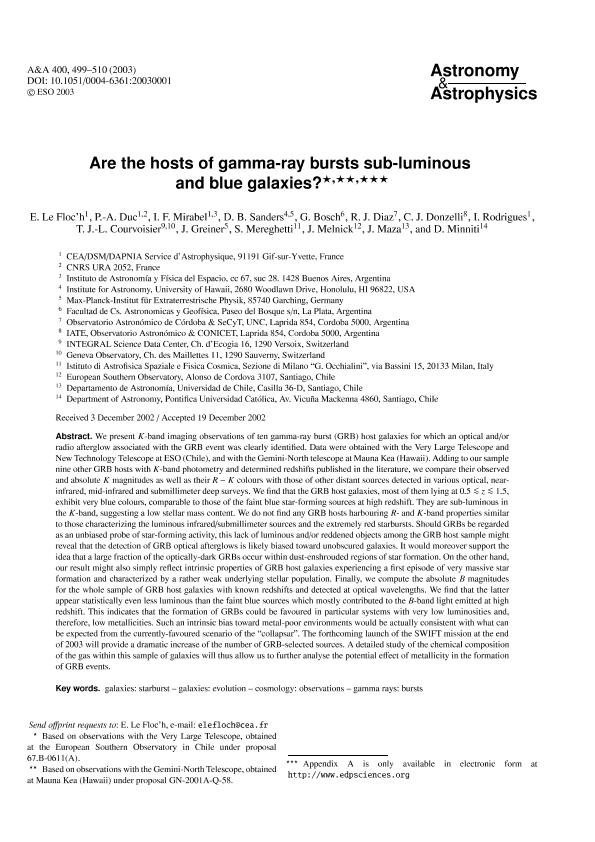Mostrar el registro sencillo del ítem
dc.contributor.author
Le Floch, E.
dc.contributor.author
Duc, P.
dc.contributor.author
Mirabel Miquele, Igor Felix

dc.contributor.author
Sanders, D.
dc.contributor.author
Bosch, Guillermo Luis

dc.contributor.author
Diaz, Ruben Joaquin

dc.contributor.author
Donzelli, Carlos Jose

dc.contributor.author
Rodrigues, I.
dc.contributor.author
Courvoisier, T.
dc.contributor.author
Greiner, J.
dc.contributor.author
Mereghetti, S.
dc.contributor.author
Melnick, J.
dc.contributor.author
Maza, J.
dc.contributor.author
Minitti, D.
dc.date.available
2018-03-21T21:54:32Z
dc.date.issued
2003-03
dc.identifier.citation
Le Floch, E.; Duc, P.; Mirabel Miquele, Igor Felix; Sanders, D.; Bosch, Guillermo Luis; et al.; Are the hosts of gamma-ray bursts sub-luminous and blue galaxies?; EDP Sciences; Astronomy and Astrophysics; 400; 2; 3-2003; 499-510
dc.identifier.issn
0004-6361
dc.identifier.uri
http://hdl.handle.net/11336/39597
dc.description.abstract
We present K-band imaging observations of ten gamma-ray burst (GRB) host galaxies for which an optical and/or radio afterglow associated with the GRB event was clearly identified. Data were obtained with the Very Large Telescope and New Technology Telescope at ESO (Chile), and with the Gemini-North telescope at Mauna Kea (Hawaii). Adding to our sample nine other GRB hosts with K-band photometry and determined redshifts published in the literature, we compare their observed and absolute K magnitudes as well as their R − K colours with those of other distant sources detected in various optical, nearinfrared, mid-infrared and submillimeter deep surveys. We find that the GRB host galaxies, most of them lying at 0.5 <∼ z <∼ 1.5, exhibit very blue colours, comparable to those of the faint blue star-forming sources at high redshift. They are sub-luminous in the K-band, suggesting a low stellar mass content. We do not find any GRB hosts harbouring R- and K-band properties similar to those characterizing the luminous infrared/submillimeter sources and the extremely red starbursts. Should GRBs be regarded as an unbiased probe of star-forming activity, this lack of luminous and/or reddened objects among the GRB host sample might reveal that the detection of GRB optical afterglows is likely biased toward unobscured galaxies. It would moreover support the idea that a large fraction of the optically-dark GRBs occur within dust-enshrouded regions of star formation. On the other hand, our result might also simply reflect intrinsic properties of GRB host galaxies experiencing a first episode of very massive star formation and characterized by a rather weak underlying stellar population. Finally, we compute the absolute B magnitudes for the whole sample of GRB host galaxies with known redshifts and detected at optical wavelengths. We find that the latter appear statistically even less luminous than the faint blue sources which mostly contributed to the B-band light emitted at high redshift. This indicates that the formation of GRBs could be favoured in particular systems with very low luminosities and, therefore, low metallicities. Such an intrinsic bias toward metal-poor environments would be actually consistent with what can be expected from the currently-favoured scenario of the “collapsar”. The forthcoming launch of the SWIFT mission at the end of 2003 will provide a dramatic increase of the number of GRB-selected sources. A detailed study of the chemical composition of the gas within this sample of galaxies will thus allow us to further analyse the potential effect of metallicity in the formation of GRB events.
dc.format
application/pdf
dc.language.iso
eng
dc.publisher
EDP Sciences

dc.rights
info:eu-repo/semantics/openAccess
dc.rights.uri
https://creativecommons.org/licenses/by-nc-sa/2.5/ar/
dc.subject
Galaxies
dc.subject
Starbursts
dc.subject
Evolution of Galaxies
dc.subject
Cosmology
dc.subject
Gamma Ray Bursts
dc.subject.classification
Astronomía

dc.subject.classification
Ciencias Físicas

dc.subject.classification
CIENCIAS NATURALES Y EXACTAS

dc.title
Are the hosts of gamma-ray bursts sub-luminous and blue galaxies?
dc.type
info:eu-repo/semantics/article
dc.type
info:ar-repo/semantics/artículo
dc.type
info:eu-repo/semantics/publishedVersion
dc.date.updated
2018-02-19T16:56:36Z
dc.journal.volume
400
dc.journal.number
2
dc.journal.pagination
499-510
dc.journal.pais
Francia

dc.journal.ciudad
Paris, France
dc.description.fil
Fil: Le Floch, E.. CEA/DSM/DAPNIA Service d’Astrophysique; Francia
dc.description.fil
Fil: Duc, P.. CEA/DSM/DAPNIA Service d’Astrophysique; Francia. Centre National de la Recherche Scientifique; Francia
dc.description.fil
Fil: Mirabel Miquele, Igor Felix. CEA/DSM/DAPNIA Service d’Astrophysique; Francia. Consejo Nacional de Investigaciónes Científicas y Técnicas. Oficina de Coordinación Administrativa Ciudad Universitaria. Instituto de Astronomía y Física del Espacio. - Universidad de Buenos Aires. Facultad de Ciencias Exactas y Naturales. Instituto de Astronomía y Física del Espacio; Argentina
dc.description.fil
Fil: Sanders, D.. Max Planck Institut für Extraterrestrische Physik; Alemania
dc.description.fil
Fil: Bosch, Guillermo Luis. Universidad Nacional de la Plata. Facultad de Ciencias Astronómicas y Geofísicas; Argentina
dc.description.fil
Fil: Diaz, Ruben Joaquin. Universidad Nacional de Cordoba. Observatorio Astronomico de Cordoba; Argentina
dc.description.fil
Fil: Donzelli, Carlos Jose. Consejo Nacional de Investigaciones Científicas y Técnicas. Centro Científico Tecnológico Conicet - Córdoba. Instituto de Astronomía Teórica y Experimental. Universidad Nacional de Córdoba. Observatorio Astronómico de Córdoba. Instituto de Astronomía Teórica y Experimental; Argentina
dc.description.fil
Fil: Rodrigues, I.. CEA/DSM/DAPNIA Service d’Astrophysique; Francia
dc.description.fil
Fil: Courvoisier, T.. INTEGRAL Science Data Center; Suiza
dc.description.fil
Fil: Greiner, J.. Max Planck Institut für Extraterrestrische Physik; Alemania
dc.description.fil
Fil: Mereghetti, S.. Istituto di Astrofisica Spaziale e Fisica Cosmica; Italia
dc.description.fil
Fil: Melnick, J.. European Southern Observatory; Chile
dc.description.fil
Fil: Maza, J.. Universidad de Chile; Chile
dc.description.fil
Fil: Minitti, D.. Pontificia Universidad Católica de Chile; Chile
dc.journal.title
Astronomy and Astrophysics

dc.relation.alternativeid
info:eu-repo/semantics/altIdentifier/doi/http://dx.doi.org/10.1051/0004-6361:20030001
dc.relation.alternativeid
info:eu-repo/semantics/altIdentifier/url/https://www.aanda.org/articles/aa/full/2003/11/aa3369/aa3369.html
Archivos asociados
